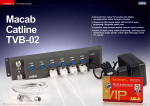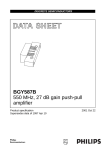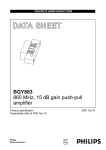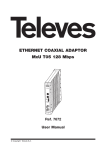Download Refs. 2333, 233310 2334, 233410 234304, 234310 2335
Transcript
Refs. 2333, 233310 2334, 233410 234304, 234310 2335, 2336 EN Optical Fiber Transmitter and Receiver User manual with return path channel w w w. t e l e v e s . c o m Optical Fiber Transmitter and Receiver Index Technical specifications . ..................................................................................................................... Reference description . ........................................................................................................................ Mounting . ............................................................................................................................................ 3.1. Wall mounting ............................................................................................................................... 3.2. 19” rack mounting ....................................................................................................................... Element description ............................................................................................................................. 4.1. Optical transmitter .................................................................................................................... 4.2. Optical receiver . ........................................................................................................................ 4.3. Power supply unit ...................................................................................................................... Examples of application ...................................................................................................................... Tables for attenuation and gain installations calculation ..................................................................... 5 9 10 10 11 12 12 13 14 15 19 EN ENGLISH 1. 2. 3. 4. 5. 6. Optical Fiber Transmitter and Receiver Important safety instructions: General installation conditions: Before handling or connecting the equipment, please read this manual. Do not obstruct the equipment’s ventilation system. Please allow air circulation around the equipment. Do not place the equipment near sources of heat or in excessively moisture conditions. Do not place the equipment where it may be affected by strong vibrations or knocks. How to use the equipment safely: If any liquid or object falls inside the equipment, please contact a specialized technician. Do not connect the equipment until all the other connections have been made. Instructions for the optical connection: For the optical connection, a single mode fibre cable is used with an SC/APC-type connector. Remove the dust cap from the optical connector located on the front panel, as well as the one of the connector of the single mode fiber to be connected to the equipment. 4 onnect the cable to the device, carefully C slotting the guides together for both connectors, pushing the connector all the way in. Precautionary measures with the connection point: T ake special care to avoid damaging the unprotected ends of the connectors, as small scratches, impurities and/or particles of dirt, oil, grease, sweat etc. may significantly affect the quality of the signal. To clean the ends of the connectors, wipe with an appropriate cleaning wipe moistened with isopropyl alcohol, specific for the cleaning of optical elements. Make sure the alcohol evaporates fully before connecting. Keep the connector covers and cable caps in a safe place in case they are needed in the future. Always fit the covers on the connectors of devices that are not connected to cables to prevent the laser beam from damaging the eyes. Avoid turning on the transmitter without having the fibre optic cable connected. Safety measures Warning.This product emits an invisible laser beam. Avoid contact with laser radiation. The use of equipment such as binoculars or magnifying glasses may increase damage caused to the eyes. According to EN60825-1_ 2007 Caution - The use of controls or adjustments, or procedures other than those specified in this manual may result in exposure of body parts to harmful radiation. -C arefully read and observe the instructions given in this manual, and keep it for future reference. -D o not use the equipment in any way that does not comply with the operating instructions or in any conditions that exceed the stipulated atmospheric specifications. - This equipment is not user-serviceable. Should you require assistance, contact our technical service department. -N ever point the laser beam intentionally at people or animals. 5 1. Technical specifications Optical transmitters Forward channel Frequency range MHz Return channel 87-862 MHz Maximum input level for dBµV CSO & CTB >= 60dB (1) 950-2150 MHz Input level regulation margin (in 2 dB steps) dB Output level regulation margin (in 2 dB steps) dB RF Return channel maximum RF output level dBµV Input/Output 850 MHz Equivalent input noise EIN dBm/Hz 2000 MHz Flatness dB Return losses dB Impedance ohm Test socket attenuation (typ.) dB Laser type Optical output Wavelength nm (forward channel) Output optical power mW/dBm Optical device type Wavelength nm Optical input (return channel) Detection bandwidth MHz Max. Optical power received mW/dBm 12 Vdc Powering/Consumption mA 24 Vdc RF connectors type General Optical connectors Operating temperature ºC Weight grs. Dimensions mm (1) Input: 41 TV CH CENELEC and 1 complete satellite transponder. The input attenuator in 0dB position. (2) Measurement made according to standard DIN45004B. 2333 233310 2334 233410 87 - 2150 ---1 - 65 91 87 91 87 80 0-18 ---0-18 112 (2) -150 - 146 ± 1,5 >= 10 75 16 MQW-DFB 1310 ± 20 4/6 10 / 10 4/6 10 / 10 InGaAs Pin Photodiode ------1200 -1600 ---1 - 3000 ---2/3 210 270 310 330 104 140 160 170 female F SC/APC -5 ··· +45 850 900 50 x 217 x 175 234304 234310 ---- 85 87 ---- 1550 ± 20 2,5 / 4 10 / 10 ------------265 325 140 160 850 EN Optical Fiber Transmitter and Receiver 6 Optical receivers 2335 Frequency range Maximum Output Level for CSO and CTB >= 60dB (1) RF Input/Output Forward channel Return channel 87-862 MHz 950-2150 MHz Output level regulation margin (in 2 dB steps) Maximum input level return path (2) Flatness Return losses Impedance Optical device Wavelength Optical input (forward channel) Detection bandwidth Maximum Optical power received Laser Optical output Wavelength (return channel) Maximum output power General RF connectors Optical connectors Operating temperature Weight Dimensions (1) Output: 42 TV CH CENELEC and 1 complete satellite transponder. The output attenuator in 0dB position. (2) According to DIN45004B. dBm/Hz dB dB ohm type nm MHz mW/dBm tipo nm mW/dBm 12 Vdc 24 Vdc ---- mA type ºC grs. mm 1 - 65 93 90 0 - 18 dBµV dB dBµV Equivalent input noise of the return channel, measured at 30 MHz and the transmitter output connected directly to the receiver Powering/Consumption MHz 2336 87 - 2150 ---- 95 -152,5 ± 1,5 >= 11 75 InGaAs Pin Photodiode 1200 -1600 1 - 3000 4/6 ---Fabry-Perot ---1310 ± 20 ---2/3 300 355 155 175 female F SC/APC -5 ··· +45 850 900 50 x 217 x 175 7 1.5. Amplifiers technical specifications Amplifier 5575 Frequency range 46 ... 862 MHz Connector type Gain 44 ± 2,5 dB Powering “F” Regulation margin 20 dB Consumption at 24 V Output level (at 60 dBc): 105 dBµV (42 CH CENELEC) Test socket 24 V : 450 mA -30 dB 1.6. Technical specs. Power Supply Unit Power Supply Unit 5629 EN Mains voltage 196 - 264 V~ 50/60 Hz Total max. current (output1 + output2): Output voltage 24V Max. current per output 5 A (24V ) 4 A (24V ) 1.7. Blocks diagrams RF INPUT (forward path) RF OUTPUT (return path) ref. 2333 ref. 233310 ref. 234304 ref. 234310 Diplexer Fwd path / Rtn path Attenuator Return path Attenuator Forward path FO INPUT Return path FO OUTPUT Forward path Converter RF FO PWR Forward path Control 2333 233310 234304 234310 Converter RF FO ref. 2334 ref. 233410 ref. 2334 ref. 233410 PWR Return path 2334 233410 LED Relay Return path Control LED Relay ref. 2333 ref. 233310 ref. 234304 ref. 2334 ref. 233410 ref. 234310 Optical Fiber Transmitter and Receiver LED 8 Relay Forward path control FO OUTPUT Return path LED 2335 Relay Return path control 2336 PWR PWR Converter FO RF ref. 2336 FO INPUT Forward path ref. 2335 ref. 2336 Converter FO RF Forward path Forward path attenuator Diplexer Fwd path / Rtn path RF OUTPUT Fwd path RF INPUT Rtn path ref. 2335 ref. 2336 9 2. Description of references Product range Accessoires 2333 T.0X Optical fiber transmitter 1310 nm 7234 Universal programmer 233310 T.0X Optical fiber transmitter 1310 nm 10dBm 5071 Wall mounting rail T03-T05-T.0X L=50 cm 2334 T.0X Optical fiber transmitter 1310 nm + Return channel receiver 5239 Wall mounting rail T03-T05-T.0X (12 modules +PSU) L= 56 cm 233410 T.0X Optical fiber transmitter 1310 nm 10dBm + Return channel receiver 5301 19” rack frame 507202 T.0X cabinet with ventilation unit (7 modules + PSU) 4061 F terminal load DC-blocked 4058 F terminal load 422601 T05 to T.0X powering adapter lead L=40 cm 422602 T05 to T.0X BUS adapter lead L=40 cm 422603 Control BUS lead T.0X L=1 m 5673 Face plate 50 mm 234304 T.0X Optical fiber transmitter 1550 nm 4dBm 234310 T.0X Optical fiber transmitter 1550 nm 10dBm 2335 T.0X Optical fiber receiver 1200-1600 nm 2336 T.0X Optical fiber receiver + Return channel transmitter 2337 T.0X 2 way optical splitter 2339 T.0X 4 way optical splitter 234401 T.0X 8 way optical splitter 1310/1550 nm 10dB 234501 T.0X 16 way optical splitter 1310/1550 nm 14dB 234601 T.0X 32 way optical splitter 1310/1550 nm 17dB 5629 T.0X Power Supply Unit 24V/5A EN Optical Fiber Transmitter and Receiver 10 3. Mounting 3.1. Wall mounting T.0X Headend 5629 F.O. transmitter CLAC! TEST UQQA-S2-T UQQA-S2-T UQQA-S2-T UQQA-S2-T UQQA-S2-T UQQA-S2-T (-12dB) RF 5071 5239 PWR TX OPTICAL PWR ALARM TX RF IN LEVEL ADJ. 4061 NOTE: We recommend using both outputs of the source, balancing consumption. Optical output 11 3.2. 19” rack mounting EN TEST UQQA-S2-T UQQA-S2-T UQQA-S2-T UQQA-S2-T UQQA-S2-T UQQA-S2-T (-12dB) RF PWR TX OPTICAL PWR ALARM 5301 TX RF IN LEVEL ADJ. UPSU120 Optical Fiber Transmitter and Receiver 12 4. Description of elements 4.1. Optical transmitter exposure to harmful radiation Ref. 2333 Ref. 233310 Ref. 234304 Ref. 234310 Ref. 2334 Ref. 233410 Caution The use of control or adjustment devices, or operating parameters other than those specified in this manual, can cause exposure to harmful radiation. 1.Test output (-16dB) 2.RF Input 87 - 2150 MHz (forward channel) 5 - 65 MHz (return channel) 3. Powering 4.ON power indicator LED 5.Forward channel power indicator LED 6.Return channel power indicator LED 7.Alarm connector 8.Forward channel optical output 9.Return channel optical input 10. Forward channel RF attenuation 11. Return channel RF attenuation Masa +12 ... 24V LED ON Indicates TX Optical PW Optical power delivered by the equipment from: (5,5 & 6,5 dBm => refs. 2333 & 2334) (9,5 & 10,5 dBm => refs. 233310 & 233410) (3,5 & 4,5 dBm => refs. 234304 & 234310) RX Optical PW Optical level received by the return channel from 3 dBm to -7 dBm. 13 4.2. Optical receiver 2 PWR 1 2.ON power indicator LED 1 1.Powering PWR TX OPTICAL PWR RX OPTICAL PWR ALARM RX OPTICAL PWR ALARM RX RF OUT LEVEL ADJ. RF RF OUT LEVEL ADJ. 2 3 4 4.Return channel power indicator LED 5.Alarm connector 6.Return channel optical output 7.Forward channel optical input TX RX 9 5 6 7 8 4 5 3.Forward channel power indicator LED RF 7 8.Forward channel attenuation 8 9.RF output 87 - 2150 MHz (forward channel) 9 5 - 65 MHz (return channel) Masa Ref. 2335 +12 ... 24V Ref. 2336 Caution The use of control or adjustment devices, or operating parameters other than those specified in this manual, can cause exposure to harmful radiation. LED ON Indicates RX Optical PW Input optical power on the device from 5 dBm and -10 dBm. TX Optical PW Optical level broadcast on the return channel between 2.5 dBm and 3.5 dBm. EN Optical Fiber Transmitter and Receiver 14 4.3. Power Supply Unit (1) Input power connectors (1) Masa Status LED 24V: OK 0V: Overloading or shortcircuiting Mains input 230V~ NOTE: You must use both outputs of the source when consumption exceeds 4 amps on either of them (maximum current for each output) 15 5. Examples of application Correct use of the devices. There are several basic concepts that should not be forgotten. The technical specifications are a set of maximums to be handled with some care. To calculate the RF level which must excite the transmitter, use the data in the table shown below and the following formulas: EIN= EINn +10×log(BW) C/N=Vin - EIN [1] [2] where: • • • • EIN is the equivalent input noise. That is, the noise in RF, which would have to be present at the input of the transmitter in an ideal optic system that did not add noise, so as to obtain the same level of noise at the output of the receiver of the real system (It always add noise). EINn is the EIN for a bandwidth of 1Hz. BW is the bandwidth of the RF signal. Vin is the RF input level, and is given in dBm. Here are some examples. Opt. Link atenuattion (dB) 0 2 4 4.5 5 5.5 6 6.5 7 7.5 8 8.5 9 9.5 10 10.5 11 11.5 12 12.5 13 13.5 14 14.5 15 15.5 16 16.5 17 Gain at 870 MHz (dB) 16.2 12.3 8.7 7.7 6.6 5.6 4.6 3.6 2.6 1.6 0.6 -0.3 -1.3 -2.3 -3.3 -4.3 -5.3 -6.3 -7.3 -8.3 -9.3 -10.3 -11.3 -12.3 -13.3 -14.3 -15.3 -16.3 -17.3 EINn (dBm/Hz) -150.4 -148.4 -146.6 -145.85 -144.9 -144.1 -143.3 -142.5 -141.6 -140.8 -139.9 -139.1 -138.2 -137.25 -136.35 -135.4 -134.5 -133.5 -132.55 -131.6 -130.6 -129.7 -128.7 -127.7 -126.7 -125.8 -124.8 -123.8 -122.8 Gain at 1.5 GHz (dB) 17.0 13.13 9.4 8.4 7.4 6.4 5.4 4.4 3.4 2.4 1.4 0.4 -0.5 -1.5 -2.5 -3.5 -4.5 -5.5 -6.5 -7.5 -8.5 -9.5 -10.5 -11.5 -12.5 -13.5 -14.5 -15.5 -16.5 EINn (dBm/Hz) -150.4 -148.9 -147.0 -146.3 -145.6 -144.8 -144.1 -143.2 -142.4 -141.6 -140.7 -139.8 -139.1 -138.1 -137.2 -136.3 -135.5 -134.47 -133.5 -132.57 -131.6 -130.65 -129.67 -128.7 -127.7 -126.7 -125.7 -124.8 -123.8 Gain at 2.15 GHz (dB) 17.4 13.4 9.7 8.7 7.7 6.7 5.7 4.7 3.7 2.7 1.7 0.7 -0.3 -1.3 -2.2 -3.2 -4.3 -5.3 -6.3 -7.3 -8.3 -9.3 -10.3 -11.3 -12.3 -13.3 -14.3 -15.3 -16.3 EINn (dBm/Hz) -146.4 -145.7 -144.9 -144.6 -144.2 -143.7 -143.2 -142.7 -142.1 -141.5 -140.8 -140.1 -139.4 -138.7 -138.0 -137.2 -136.3 -135.5 -134.6 -133.7 -132.8 -131.9 -131.0 -130.1 -129.2 -128.2 -127.3 -126.3 -125.4 Measurements made with a transmitter that delivers 6.1 dBm, followed by a reel of fiber of 5 km long and an optical attenuator connected between the end of the reel of fiber and optical receiver input. EN Optical Fiber Transmitter and Receiver Example 1 16 link in the value of 0.6 dB, which would correspond EINn =-139.9 dB/Hz. Calculate the C / N at the output of the optical receiver (C/N of the link), in the installation of the figure below: This is a link where the optical signal is split between 4 fibers of 1 km, using a splitter ref. 2339. The signal received at the other end is converted back to RF by means of the optical receiver ref. 2335. Apply the formula [1] and we obtain: EINTV= -139.9 + 10×log(5×106)= -72.91 dBm Now apply the formula [2] to calculate the C/N, as follows: C/NTV=Vin - EINTV C/NTV = -26 dBm -(- 72.9 dBm) = -26+72.9 Then, C/NTV = 46.9 dB In practice, having satellite channels, simultaneously with the TV ones, makes the latter worse their C/N in 1 dB. The channel levels that excite the transmitter are: - 83 dBµV (-26 dBm 42CH CENELEC) analog channels, TV band. (1) RF signal TV + SAT - 73 dBµV (-36 dBm) digitales channels, SAT band. Analog terrestrial channel bandwidth: 5 MHz • The 2 fiber optic connectors represent 0.8 dB (2 × 0.4). (2) RF signal TV + SAT 1 Km • The splitter features 6.8 dB loss. INPUT signal TV + SAT • 1 km optical fiber is equivalent to 0.4 dB of attenuation. On the other hand: Satellite digital transponder bandwidth: 27 MHz (3) Therefore, total losses of the optical fiber link are: RF signal TV + SAT FO losses+Optical splitter losses+Connectors losses 0.4 + 6.8 + 0.8 = 8 dB Now we use the formulas and data given in the table above. For the TV band, we consider the column of the Gain at 807 MHz. This column intersects with the row of 8 dB of loss calculated for the optical fiber This is: (4) RF signal TV + SAT 17 Now we do the calculation for digital satellite channels, following the same process above, but by looking at the column Gain at 2 .1 GHz of the table (band in which are delivered digital channels) and the following results : EINn= -140.8 dB/Hz EINSAT = -140.8 + 10×log(27×106) = - 65.7 dBm • The 2 fiber optic connectors represent 0.8 dB. For the TV band, in the column Gain at 807 MHz Therefore, the total losses of the fiber optics are: EINn (TV)= -122.8 dBm/Hz G(807 MHz)= -17.3 dB 0.4 + 16 + 0.8 = 17.2 dB (let’s take 17 dB for this case, maximum value shown in the table) And for SAT band, look in the Gain at 2.1 GHz column. The table provides the following information: EINn(SAT) = -125.4 dBm/Hz EN C/NSAT = -36-(-65.7) = -36 + 65.7 C/NSAT = 29.7 dB As the input level is -36 dBm, C/N is: (1) RF signal TV + SAT Example 2 be DVB-S2, with a (2) RF signal TV + SAT SAT channels will C/NDVBS2= 14 dB. INPUT signal TV + SAT Thus, the TV channels will be COFDM channels with a C/NCOFDM = 23 dB. Let’s repeat the example above but applied to an installation with a 32 output optical splitter. The channels will be digital only. 1 Km The level of excitation of the transmitter will be the same for TV and SAT: 79 dBµV (-30dBm). For COFDM: BW = 8×106 Hz (8 MHz) For SAT: BW = 27×106 Hz (27 MHz) As in Example 1, the attenuations are: • 1 km of fiber is 0.4 dB. • The 32 output optical splitter represents about 16 dB The bandwidth will be now: (32) RF signal TV + SAT Optical Fiber Transmitter and Receiver 18 G(2.1 GHz)= -16.3 dB RETURN CHANNEL Therefore, the RF signal level delivered by the receiver is: For the return channel transmitter, the table of attenuations, link gain and equivalent noise is: Vout rcvr (dBµV) = Vin xmtr (dBµV) + G (dB) This is: Vout rcvr TERR (dBµV) = 79 -17.3 = 61.7 dBµV Vout rcvr SAT (dBµV) = 79 -16.3 = 62.7 dBµV Applying the formula [1]: EINTV = EINn(TV) + 10×log(8×106) [dBm] EINTV = -122.8 + 69 EINTV = -53.8 dBm And by the formula [2] is obtained: C/N TV= - 30 dBm - (- 53.8 dBm) = 23.8 dB en TV Likewise, we calculate the C/N for SAT channels, resulting in: EINSAT= - 51.1 dBm C/NSAT= -30 - (-51.1) = 21.1 dB en SAT If we estimate the value of the C / N for TV very tight, you can increase the excitement level of the transmitter a couple of dB, since there is enough margin before the system begins to distort. Link attenuation Gain at 30 MHz (dB) (dB) 0 3 4 5 6 7 8 9 10 11 12 13 14 23 16.6 14.6 12.7 10.7 8.7 6.7 4.7 2.6 0.4 -1.5 -3.5 -5.5 EINn (dBm/Hz) -152.5 -149.5 -147.6 -145.7 -143.9 -141.9 -140 -138.1 -136 -133.4 -132 -130.5 -128.5 Measurements made with a transmitter that delivers 2.9dBm followed by an optical attenuator connected between the transmitter and the optical receiver. Use the formulas 1 and 2 for making calculations. The calculation process is the same as in the case of the forward channel. 19 6. Tables for attenuation and gain installations calculation Refs. 2333, 2334 (TRANSMISSION) Opt. Link Gain Popt IN in RX atenuattion at 870 MHz (dBm) (dB) (dB) 0 6 16,2 2 4 12,3 4 2 8,7 4,5 1,5 7,7 5 1 6,6 5,5 0,5 5,6 6 0 4,6 6,5 -0,5 3,6 7 -1 2,6 7,5 -1,5 1,6 8 -2 0,6 8,5 -2,5 -0,3 9 -3 -1,3 9,5 -3,5 -2,3 10 -4 -3,3 10,5 -4,5 -4,3 11 -5 -5,3 11,5 -5,5 -6,3 12 -6 -7,3 12,5 -6,5 -8,3 13 -7 -9,3 13,5 -7,5 -10,3 14 -8 -11,3 14,5 -8,5 -12,3 15 -9 -13,3 15,5 -9,5 -14,3 16 -10 -15,3 16,5 -10,5 -16,3 17 -11 -17,3 Ref. 2334 (RETURN) EINn (dBm/Hz) -150,4 -148,4 -146,6 -145,85 -144,9 -144,1 -143,3 -142,5 -141,6 -140,8 -139,9 -139,1 -138,2 -137,25 -136,35 -135,4 -134,5 -133,5 -132,55 -131,6 -130,6 -129,7 -128,7 -127,7 -126,7 -125,8 -124,8 -123,8 -122,8 Gain at 1.5 GHz (dB) 17 13,13 9,4 8,4 7,4 6,4 5,4 4,4 3,4 2,4 1,4 0,4 -0,5 -1,5 -2,5 -3,5 -4,5 -5,5 -6,5 -7,5 -8,5 -9,5 -10,5 -11,5 -12,5 -13,5 -14,5 -15,5 -16,5 EINn (dBm/Hz) -150,4 -148,9 -147 -146,3 -145,6 -144,8 -144,1 -143,2 -142,4 -141,6 -140,7 -139,8 -139,1 -138,1 -137,2 -136,3 -135,5 -134,47 -133,5 -132,57 -131,6 -130,65 -129,67 -128,7 -127,7 -126,7 -125,7 -124,8 -123,8 Gain at 2.15 GHz (dB) 17,4 13,4 9,7 8,7 7,7 6,7 5,7 4,7 3,7 2,7 1,7 0,7 -0,3 -1,3 -2,2 -3,2 -4,3 -5,3 -6,3 -7,3 -8,3 -9,3 -10,3 -11,3 -12,3 -13,3 -14,3 -15,3 -16,3 EINn (dBm/Hz) -146,4 -145,7 -144,9 -144,6 -144,2 -143,7 -143,2 -142,7 -142,1 -141,5 -140,8 -140,1 -139,4 -138,7 -138 -137,2 -136,3 -135,5 -134,6 -133,7 -132,8 -131,9 -131 -130,1 -129,2 -128,2 -127,3 -126,3 -125,4 Measurements made with a transmitter that delivers 6.1 dBm, followed by a reel of fiber of 5 km long and an optical attenuator connected between the end of the reel of fiber and optical receiver input. Link attenuat. Gain at 30 MHz EINn (dB) (dB) (dBm/Hz) 0 3 4 5 6 7 8 9 10 11 12 13 14 23 16,6 14,6 12,7 10,7 8,7 6,7 4,7 2,6 0,4 -1,5 -3,5 -5,5 -152,5 -149,5 -147,6 -145,7 -143,9 -141,9 -140 -138,1 -136 -133,4 -132 -130,5 -128,5 Measurements made with a transmitter that delivers 2.9dBm followed by an optical attenuator connected between the transmitter and the optical receiver. EN Optical Fiber Transmitter and Receiver 20 Refs. 233310, 233410 (TRANSMISSION) Opt. Link atenuattion (dB) 6 6,5 7 7,5 8 8,5 9 9,5 10 10,5 11 11,5 12 12,5 13 13,5 14 14,4 15 15,5 16 16,5 17 17,5 18 18,5 19 Popt IN in RX (dBm) 4 3,5 3 2,5 2 1,5 1 0,5 0 -0,5 -1 -1,5 -2 -2,5 -3 -3,5 -4 -4,5 -5 -5,5 -6 -6,5 -7 -7,5 -8 -8,5 -9 Gain at 870 MHz (dB) 7,5 6,5 5,5 4,5 3,5 2,5 1,5 0,5 -0,5 -1,5 -2,5 -3,5 -4,5 -5,5 -6,5 -7,5 -8,5 -9,5 -10,5 -11,5 -12,5 -13,5 -14,5 -15,5 -16,5 -17,5 -18,5 Ref. 233410 (RETURN) EINn (dBm/Hz) -144,8 -144,2 -143,5 -142,6 -142 -141,3 -140,5 -139,8 -139 -138,2 -137,4 -136,5 -135,8 -134,8 -133,9 -132,9 -132,1 -131,2 -130,2 -129,4 -128,4 -127,5 -126,6 -125,7 -124,7 -123,6 -122,6 Gain at 1.5 GHz (dB) 8,1 7,1 6,1 5,1 4,1 3,1 2,1 1,1 0,1 -0,9 -1,9 -2,9 -3,9 -4,9 -5,9 -6,9 -7,9 -8,9 -9,9 -10,9 -11,9 -12,9 -13,9 -14,9 -15,9 -16,9 -17,9 EINn (dBm/Hz) -144,1 -143,6 -143,1 -142,6 -142,1 -141,4 -140,8 -140,2 -139,5 -138,7 -138,1 -137,3 -136,6 -135,5 -134,7 -133,6 -132,8 -132 -131,1 -130,1 -129,3 -128,4 -127,6 -126,6 -125,6 -124,7 -123,7 Gain at 2.15 GHz (dB) 6,7 5,7 4,7 3,7 2,7 1,7 0,7 -0,3 -1,3 -2,3 -3,3 -4,3 -5,3 -6,3 -7,3 -8,3 -9,3 -10,3 -11,3 -12,2 -13,3 -14,3 -15,3 -16,3 -17,3 -18,3 -19,3 EINn (dBm/Hz) -142,7 -142,4 -142 -141,7 -141,2 -141 -140,5 -140 -139,2 -138,9 -138,3 -137,7 -137 -136,2 -135,4 -134,5 -133,7 -133 -132,2 -131,5 -130,6 -130 -129 -128,1 -127,3 -126,2 -125,3 Measurements made with a transmitter that delivers 10 dBm, followed by a reel of fiber of 5 km long and an optical attenuator connected between the end of the reel of fiber and optical receiver input. Link attenuat. Gain at 30 MHz (dB) (dB) 0 3 4 5 6 7 8 9 10 11 12 13 14 23 16,6 14,6 12,7 10,7 8,7 6,7 4,7 2,6 0,4 -1,5 -3,5 -5,5 EINn (dBm/Hz) -152,5 -149,5 -147,6 -145,7 -143,9 -141,9 -140 -138,1 -136 -133,4 -132 -130,5 -128,5 Measurements made with a transmitter that delivers 2.9dBm followed by an optical attenuator connected between the transmitter and the optical receiver. 21 Ref. 234304 (TRANSMISSION) Opt. Link atenuattion (dB) 1,7 2,2 2,7 3,2 3,7 4,2 4,7 5,2 5,7 6,2 6,7 7,2 7,7 8,2 8,7 9,2 9,7 10,2 10,7 11,2 11,7 12,2 12,7 13,2 13,7 14,2 14,7 15,2 15,7 16,2 Popt IN in RX (dBm) 2,5 2 1,5 1 0,5 0 -0,5 -1 -1,5 -2 -2,5 -3 -3,5 -4 -4,5 -5 -5,5 -6 -6,5 -7 -7,5 -8 -8,5 -9 -9,5 -10 -10,5 -11 -11,5 -12 Gain at 870 MHz (dB) 14,3 13,4 12,4 11,4 10,4 9,4 8,4 7,4 6,4 5,5 4,5 3,6 2,5 1,6 0,5 -0,5 -1,4 -2,4 -3,3 -4,3 -5,3 -6,4 -7,4 -8,4 -9,4 -10,4 -11,4 -12,4 -13,4 -14,3 EINn (dBm/Hz) -149,7 -149,3 -148,8 -148,4 -147,7 -147,1 -146,5 -145,8 -145,1 -144,5 -143,7 -143 -142,1 -141,3 -140,5 -139,6 -138,8 -137,8 -137,1 -136,1 -135,1 -134,2 -133,2 -132,3 -131,3 -130,4 -129,4 -128,4 -127,5 -126,6 Gain at 1.5 GHz (dB) 15 14 13 12 11 10 9 8 7,1 6,1 5,1 4,2 3,2 2,2 1,1 0,1 -0,75 -1,7 -2,7 -3,7 -4,7 -5,8 -6,8 -7,7 -8,7 -9,7 -10,7 -11,7 -12,7 -13,7 EINn (dBm/Hz) -148,8 -148,5 -148,2 -147,7 -147,3 -146,8 -146,3 -145,8 -145,3 -144,6 -144 -143,4 -142,7 -141,9 -141,1 -140 -139,6 -138,7 -137,8 -137 -136 -135 -134,1 -133,3 -132,3 -131,4 -130,4 -129,5 -128,5 -127,6 Gain at 2.15 GHz (dB) 14 13,1 12,1 11,1 10,2 9,2 8,2 7,16 6,16 5,1 4,2 3,3 2,2 1,3 0,2 -0,8 -1,7 -2,7 -3,6 -4,7 -5,7 -6,7 -7,7 -8,7 -9,7 -10,7 -11,7 -12,7 -13,7 -14,6 EINn (dBm/Hz) -146,6 -146,5 -146,3 -146,1 -146 -145,7 -145,5 -145,2 -144,8 -144,4 -144 -143,6 -143 -142,5 -141,9 -141,4 -140,7 -140 -139,4 -138,6 -137,8 -137 -136,2 -135,3 -134,5 -133,6 -132,7 -131,8 -130,9 -130,1 Measurements made with a transmitter that delivers 4 dBm, followed by a reel of fiber of 5 km long and an optical attenuator connected between the end of the reel of fiber and optical receiver input. EN Optical Fiber Transmitter and Receiver 22 Ref. 234310 (TRANSMISSION) Opt. Link atenuattion (dB) 6 6,5 7 7,5 8 8,5 9 9,5 10 10,5 11 11,5 12 12,5 13 13,5 14 14,4 15 15,5 16 16,5 17 17,5 18 18,5 19 Popt IN in RX (dBm) 4 3,5 3 2,5 2 1,5 1 0,5 0 -0,5 -1 -1,5 -2 -2,5 -3 -3,5 -4 -4,5 -5 -5,5 -6 -6,5 -7 -7,5 -8 -8,5 -9 Gain at 870 MHz (dB) 6 5 4 3 2 1 0 -1 -2 -3 -4 -5 -6 -7 -8 -9 -10 -11 -12 -13 -14 -15 -16 -17 -18 -19 -20 EINn (dBm/Hz) -142,9 -142,3 -141,5 -140,9 -140,1 -139,4 -138,6 -137,9 -137 -136,2 -135,4 -134,5 -133,7 -132,8 -131,9 -131 -130,1 -129,2 -128,3 -127,4 -126,5 -125,5 -124,6 -123,7 -122,8 -121,7 -120,8 Gain at 1.5 GHz (dB) 6,2 5,2 4,2 3,2 2,2 1,2 0,2 -0,8 -1,8 -2,8 -3,8 -4,8 -5,8 -6,8 -7,8 -8,8 -9,8 -10,8 -11,8 -12,8 -13,8 -14,8 -15,8 -16,8 -17,8 -18,8 -19,8 EINn (dBm/Hz) -142,4 -141,9 -141,4 -141 -140,2 -139,6 -138,8 -138 -137,2 -136,4 -135,5 -134,6 -133,9 -133 -132,2 -131,3 -130,3 -129,4 -128,4 -127,5 -126,7 -125,7 -124,8 -123,8 -122,8 -121,9 -120,9 Gain at 2.15 GHz (dB) 5 4 3 2 1 0 -1 -2 -3 -4 -5 -6 -7 -8 -9 -10 -11 -12 -13 -14 -15 -16 -17 -18 -19 -21 -22 EINn (dBm/Hz) -141,2 -140,5 -140,2 -139,7 -139 -138,3 -137,5 -136,7 -136 -135,2 -134,3 -133,5 -132,6 -131,7 -130,8 -130 -129,1 -128,2 -127,3 -126,4 -125,5 -124,6 -123,6 -122,6 -121,7 -120,7 -118,8 Measurements made with a transmitter that delivers 10 dBm, followed by a reel of fiber of 5 km long and an optical attenuator connected between the end of the reel of fiber and optical receiver input. 23 Guarantee Televés S.A. offers a two year guarantee, beginning from the date of purchase for countries in the EU. For countries that are not part of the EU, the legal guarantee that is in force at the time of purchase is applied. Keep the purchase invoice to determine this date. During the guarantee period, Televés S.A. complies with the guarantee by repairing or substituting the faulty equipment. The harm produced by improper usage, wear and tear, manipulation by a third party, catastrophes or any other cause beyond the control of Televés S.A. is not included in the guarantee. EN 2333-233310-2334-233410-234304-234310-2335-2336_003_EN








































